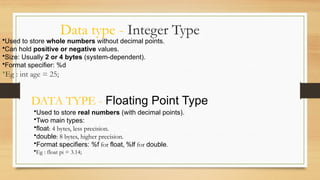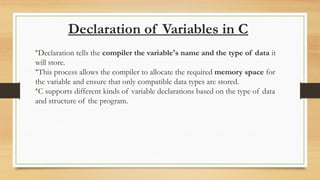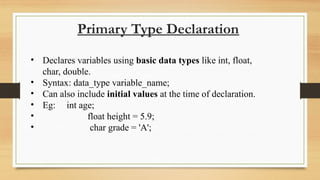Basic of Structered Programming in C psd
- 2. History of c 1967 – Martin Richards Developed a BCPL 1970 – Ken Thompson Developed a Simply B 1972- Dennis Ritchie at Bell Laboratories Developed a C
- 3. Sample Program #include<studio.h> Main() { printf (“First Program”) } Main() is function Begging of program Printf is a inbuilt function #pre-processor directive
- 4. Structure of C Program // Program to add two numbers #include <stdio.h> // Preprocessor directive int main() { // Main function int a = 10, b = 20; // Variable declaration int sum = a + b; // Executable statement printf("Sum = %d", sum); return 0; }
- 5. Character Set 1. Letters •Uppercase: A to Z •Lowercase: a to z 2. Digits •0 to 9 3. Special Characters •Symbols like: ~ ! @ # % ^ & * ( ) _ - + = { } [ ] | : ; " ' < > , . ? / 4. White Spaces •Blank space ( ) •Tab (t) •Newline (n) 5. Escape Sequences •Represent special characters using a backslash () •n – Newline •t – Tab • – Backslash •' – Single quote •" – Double quote
- 6. C Tokens Token Type Description Examples 1. Keywords Predefined, reserved words with special meaning in C int, float, if, else, return 2. Identifiers Names given to variables, functions, arrays, etc. by the programmer main, total, sum, mark1 3. Constants Fixed values that do not change during program execution 100, 3.14, 'A', "Hello" 4. Operators Symbols used to perform operations on data +, -, *, /, ==, &&, != 5. Special Symbols Symbols used in syntax and structure of C programs ;, {}, (), #, " 6. Separators (Punctuators) Symbols used to separate statements and blocks ;, ,, {}, ()
- 7. Key words Data Type Purpose Bytes Format Specifer int Number 4 %d char [a-z],[A-Z],[0-9],[*?# %@!........] 1 %c float Decimal & scientific notation 4 %f double Very big number- Decimal & scientific notation 8 %lf
- 8. Key words
- 9. Identifiers •Names given by the programmer for variables, functions, arrays, etc. •Created to make the program readable and meaningful. •Must follow naming rules: •First Char Must be a alphabet (or underscore). •Must consist of only letters, digits, or underscore (_) •only first 31 characters are significant •Must not contain white space •Cannot use keywords as identifiers •Example: total, main, mark1, display_sum
- 10. Constants •Constants are a fixed values that do not change during the execution of Program •C Supports Several types of Constants
- 11. Integer Constants •Integer Constant refer to sequence of digits •There are three type of integers •Decimal integer constants •Octal integer constants •Hexa Decimal integer constants
- 12. Decimal Integer Constants •Consist of a set of digits 0-9 proceded by on optional – or + sign •Eg: – 234 -456 0 3564588 +23 •White space( ), commas(,) and non digit ($@&) are not permitted OCTAL INTEGER CONSTANTS •Any combination of digits from the set 0-7 with leading 0 •Eg: 089 0 078652 023 HEXADECIMAL INTEGER CONSTANTS •Any sequence of digits proceded by 0x or 0X considered by hexadecimal integer •Alphabets – A through F or a through f (A-F represent number 10-15) •Eg: 0x2 0x4F
- 13. Real Constants •Integer number are inadequate to represent quanitites that vary continuously, such as disatance, heights, temperatures, prices and so on •Eg- 17.548 are real or floating point constant •Real Number may also be expressed in exponential (or Scientific notation) •Eg: 215.65 may be written as 2.1565e2 in exponential notation
- 14. Single character Constants •A single character constant contains a single character enclosed within a pair of single quotes marks •Eg- ‘5; ‘X’ •Printf(“%d”,’a’); Would print the number 97
- 15. String Constants •A String constant is a sequence of character enclosed in double quotes •The character may be letters, number,special characters & blank space •Eg- “hello” :1985” “Good Class”
- 16. Backslash character Constants •A String constant is a sequence of character enclosed in double quotes •The character may be letters, number,special characters & blank space •Eg- “hello” :1985” “Good Class”
- 17. Variables • Variables are named storage locations used to store data. • Value of a variable can change during program execution. • Must be declared before use with a data type. Rules for Naming Variables: 1.Must begin with a letter or underscore ( _ ) 2.Can include letters, digits, and underscores 3.Cannot start with a digit 4.Cannot use C keywords like int, return 5.Variable names are case-sensitive Example: int age = 20;
- 18. Data type •In C, a data type defines the type of data a variable can store, such as integers, decimals, or characters. •It tells the compiler how much memory to allocate and how to interpret the stored value. •Every variable must be declared with a data type before it is used in the program. •Data types ensure type safety, efficient memory usage, and help prevent errors. •ANSI C supports three classes of data types: 1.Primary Data Types – int, float, char, void 2.Derived Data Types – Arrays, Pointers, Functions 3.User-Defined Data Types – struct, union, enum •Correct use of data types improves program efficiency, readability, and debuggability.
- 19. Data type - Integer Type •Used to store whole numbers without decimal points. •Can hold positive or negative values. •Size: Usually 2 or 4 bytes (system-dependent). •Format specifier: %d •Eg : int age = 25; DATA TYPE - Floating Point Type •Used to store real numbers (with decimal points). •Two main types: •float: 4 bytes, less precision. •double: 8 bytes, higher precision. •Format specifiers: %f for float, %lf for double. •Eg : float pi = 3.14;
- 20. Data type - Void Type •Represents no data type / no value. •Commonly used: •For functions that do not return a value. •To declare generic pointers (void *ptr). •No memory is allocated for void type •Eg - void display(); // Function with no return type DATA TYPE - CHARACTER TYPE •Used to store a single character. •Occupies 1 byte of memory. •Internally stores the ASCII value of the character. •Format specifier: %c •Eg- char grade = 'A';
- 21. Declaration of Variables in C •Declaration tells the compiler the variable's name and the type of data it will store. •This process allows the compiler to allocate the required memory space for the variable and ensure that only compatible data types are stored. •C supports different kinds of variable declarations based on the type of data and structure of the program.
- 22. Primary Type Declaration • Declares variables using basic data types like int, float, char, double. • Syntax: data_type variable_name; • Can also include initial values at the time of declaration. • Eg: int age; • float height = 5.9; • char grade = 'A';
- 23. User-Defined Type Declaration •Uses custom data types created by the programmer. •Includes: struct, union, enum, and typedef. •Allows grouping of different data types under a single unit. •Used for creating complex and readable programs. •Eg: • struct Student { • int id; • char name[30]; • }; • typedef int Marks; • enum Week { Mon, Tue, Wed };
- 24. Assigning Values to Variables in C •Assignment is done using the = operator. •Syntax: variable_name = value; •Can assign: • Constants (e.g., int a = 10;) • Expressions (e.g., sum = a + b;) • Another variable's value (e.g., x = y;) •Can assign value: • At the time of declaration • After declaration, anywhere in the program •Assignment is from right to left (value → variable)
- 25. Declaring a Variable as Constant in C •Use the keyword const to make a variable read-only. •Syntax: const data_type variable_name = value; •Once assigned, the value cannot be changed. •Commonly used for values like: • Mathematical constants (PI) • Limits (MAX, MIN) • Configuration values •Eg: • const float PI = 3.14; // Constant for value of π • const int MAX_STUDENTS = 50; // Maximum number of students
- 26. Declaring a Variable as Volatile •Volatile is a type qualifier in C. •Used when a variable’s value may change at any time, without any action by the code. •Prevents the compiler from applying optimizations that assume the variable does not change. •Ensures the variable is always read directly from memory. •Commonly used in: • Embedded systems • Interrupts • Multi-threading/shared memory




![Character Set
1. Letters
•Uppercase: A to Z
•Lowercase: a to z
2. Digits
•0 to 9
3. Special Characters
•Symbols like: ~ ! @ # % ^ & * ( ) _ -
+ = { } [ ] | : ; " ' < > , . ? /
4. White Spaces
•Blank space ( )
•Tab (t)
•Newline (n)
5. Escape Sequences
•Represent special characters using a
backslash ()
•n – Newline
•t – Tab
• – Backslash
•' – Single quote
•" – Double quote](https://image.slidesharecdn.com/cprogram-250706104310-f3cfe010/85/Basic-of-Structered-Programming-in-C-psd-5-320.jpg)

![Key words
Data Type Purpose Bytes Format Specifer
int Number 4 %d
char [a-z],[A-Z],[0-9],[*?#
%@!........]
1 %c
float Decimal & scientific
notation
4 %f
double Very big number-
Decimal & scientific
notation
8 %lf](https://image.slidesharecdn.com/cprogram-250706104310-f3cfe010/85/Basic-of-Structered-Programming-in-C-psd-7-320.jpg)















![User-Defined Type Declaration
•Uses custom data types created by the programmer.
•Includes: struct, union, enum, and typedef.
•Allows grouping of different data types under a single unit.
•Used for creating complex and readable programs.
•Eg:
• struct Student {
• int id;
• char name[30];
• };
• typedef int Marks;
• enum Week { Mon, Tue, Wed };](https://image.slidesharecdn.com/cprogram-250706104310-f3cfe010/85/Basic-of-Structered-Programming-in-C-psd-23-320.jpg)


